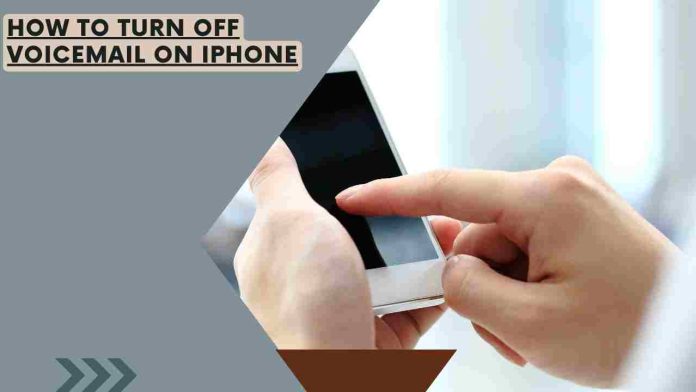Voicemail is a convenient feature that allows callers to leave a message when you’re unable to answer your iPhone. However, there are instances when you might prefer not to use it. This comprehensive guide will walk you through the process of disabling voicemail on your iPhone, ensuring you have complete control over your incoming calls.
Understanding Voicemail on iPhone
Before you decide to turn off voicemail, it’s essential to understand how this feature works on iPhones.
What is Voicemail?
Voicemail is a service provided by mobile carriers that allows callers to leave voice messages when you’re unavailable or choose not to answer your phone.
Reasons to Turn Off Voicemail
There are several valid reasons why you might want to disable voicemail:
- Prefer Immediate Communication: Some individuals prefer direct conversations and want to eliminate the intermediary step of checking voicemails.
- Avoiding Unwanted Messages: If you receive a high volume of unsolicited calls or spam, disabling voicemail can prevent your inbox from filling up with unwanted messages.
- Preserving Battery Life: Constantly checking voicemails can drain your battery, so turning off voicemail might be beneficial if you’re in a situation where charging isn’t readily available.
Disabling Voicemail: Step-by-Step Guide
Follow these steps to turn off voicemail on your iPhone:
Step 1: Open the Phone App
Begin by locating and opening the “Phone” app on your iPhone. This app is typically found on your home screen.
Step 2: Access the Keypad
In the bottom menu of the Phone app, locate and tap on the “Keypad” icon. This will bring up the numeric keypad.
Step 3: Disable Call Forwarding
To turn off voicemail, you’ll need to disable call forwarding. Here’s how:
- For AT&T and T-Mobile Users:
- Dial
##004#and press the “Call” button. This code deactivates call forwarding for all types of calls, including voicemail.
- Dial
- For Verizon Users:
- Dial
*73and press the “Call” button. This code turns off conditional call forwarding, which includes voicemail forwarding.
- Dial
- For Sprint Users:
- Dial
*38and press the “Call” button. This code disables conditional call forwarding, which includes voicemail forwarding.
- Dial
Step 4: Verify Deactivation
After entering the respective code for your carrier, you should receive a confirmation message on the screen indicating that call forwarding, including voicemail, has been successfully disabled.
Common Issues and Troubleshooting
While the above steps should work for most users, there might be exceptions or unique circumstances. Here are some common issues and troubleshooting steps:
Issue 1: Code Not Working
If the code you entered doesn’t seem to be working, ensure you’ve entered it correctly. If the problem persists, contact your carrier’s customer support for assistance.
Issue 2: Voicemail Still Active
In some cases, it might take a short while for the changes to take effect. If voicemail is still active after following the steps, restart your iPhone and check again.
Considerations and Alternatives
Before you completely disable voicemail, consider the following:
Alternative 1: Conditional Call Forwarding
If you only want to disable voicemail in specific situations, consider using conditional call forwarding. This allows you to redirect calls when you’re busy, unreachable, or don’t answer within a certain time frame.
Alternative 2: Use a Third-Party Voicemail Service
If you want to customize your voicemail experience, consider using a third-party voicemail service that provides more control over your messages.
Setting Clear Expectations
When you disable voicemail, it’s important to communicate this change to your contacts. Update your voicemail greeting to inform callers that you’ve chosen not to use voicemail and provide an alternative method of reaching you, such as a text message or email.
Utilizing Alternative Communication Methods
Without voicemail, it’s crucial to be responsive through other means. Consider using messaging apps, email, or even setting up an auto-reply message for missed calls to ensure you maintain effective communication.
Voicemail vs. Conditional Call Forwarding
Understanding the key differences between disabling voicemail and using conditional call forwarding can help you make an informed decision.
Voicemail:
- All or Nothing: Disabling voicemail means all calls will ring indefinitely until answered or ignored.
- Direct Call Routing: There’s no intermediary step – calls come directly to your phone.
Conditional Call Forwarding:
- Selective Call Routing: You can set conditions (e.g., busy, unanswered) for call forwarding, allowing for more control over call management.
- Potential Charges: Depending on your carrier and plan, conditional call forwarding might incur additional charges.
Reverting Changes and Re-Enabling Voicemail
If you decide to re-enable voicemail in the future, the process is straightforward.
Step 1: Access Call Forwarding Settings
Follow the steps outlined in the initial guide to access call forwarding settings on your iPhone.
Step 2: Enable Voicemail
Use the appropriate code for your carrier to enable voicemail:
- AT&T and T-Mobile Users: Dial
*004#and press the “Call” button. - Verizon Users: Dial
*71and press the “Call” button. - Sprint Users: Dial
*28and press the “Call” button.
Step 3: Verify Activation
You should receive a confirmation message indicating that voicemail has been successfully re-enabled.
Voicemail and Call Accessibility
Consider the accessibility aspect when making decisions about voicemail. For some individuals, voicemail can be a crucial tool, particularly for those with hearing impairments or specific communication needs. If you have contacts who rely on voicemail for accessibility reasons, consider discussing alternative methods of communication with them.
Conclusion
Turning off voicemail on your iPhone is a straightforward process, but it’s important to understand the implications of doing so. By following the steps outlined in this guide, you can effectively disable voicemail and take full control of your incoming calls.
Always remember that preferences and circumstances may change, so you can revisit these steps at any time if you decide to re-enable voicemail on your iPhone. Whether it’s for immediate communication, battery preservation, or avoiding unwanted messages, having the ability to customize your phone’s functionality is one of the advantages of owning an iPhone.








